 Early
History of California
Early
History of California
Early
History of
San
Francisco
"Ranch
and Mission Days in Alta California," by Guadalupe Vallejo
"Life
in California Before the Gold Discovery,"
by
John Bidwell
1846
Lithograph of
Yerba
Buena
Yerba
Buena Before the Gold Rush
1846
- Gen. Fremont and the Bear Flag Revolt
Capt.
Montgomery Ends Indian Slavery
Lt.
Bartlett Changes Name
of
Yerba Buena to
San
Francisco
|
From the 1820s to the Gold
Rush
Early in the nineteenth century, ships from
Boston began to visit the Spanish towns and Missions along the upper and
lower California coast. They came first to barter for both otter and beaver
pelts; later for tallow, hides, and materials used by the natives and settlers.
In the 1820s American trappers and hunters began to drift into the State
from the East. These early pioneers of the West were sometimes harshly
treated by the earlier Spanish governors, later they were welcomed; but
they had to show passports and submit to surveillance. Later, some new
arrivals married the daughters of wealthy Mexican ranchers, and took up
large land grants.
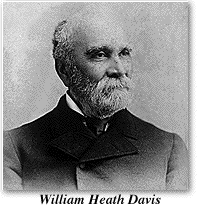 William
Heath Davis visited the California coast in 1831 aboard the trading bark
Louisa, one of the many Boston vessels that combed the trading spots of
the Pacific under the guidance of inquisitive and venturesome Yankee skippers.
Davis gives a lively account of life, barter and primitive surroundings
of the Missions, ranchos and life of that period. Mexican rule, of course,
prevailed. The some of the comparatively few foreigners accumulated big
ranchos and fortunes. Davis did so well on the trip, and was so delighted
with his adventure in this strange land that he returned two years later
aboard the trading bark Volunteer. These Yankee traders scraped up all
the commodities in sight and touch at San Diego, Los Angeles, Santa Barbara,
Monterey, San Francisco and other coast ports. William
Heath Davis visited the California coast in 1831 aboard the trading bark
Louisa, one of the many Boston vessels that combed the trading spots of
the Pacific under the guidance of inquisitive and venturesome Yankee skippers.
Davis gives a lively account of life, barter and primitive surroundings
of the Missions, ranchos and life of that period. Mexican rule, of course,
prevailed. The some of the comparatively few foreigners accumulated big
ranchos and fortunes. Davis did so well on the trip, and was so delighted
with his adventure in this strange land that he returned two years later
aboard the trading bark Volunteer. These Yankee traders scraped up all
the commodities in sight and touch at San Diego, Los Angeles, Santa Barbara,
Monterey, San Francisco and other coast ports.
According to Davis on his trip to San
Francisco in 1833: "We anchored in a cove known as Yerba Buena. Telegraph
Hill was then called Loma Alto. At that time there were some half dozen
barks from Atlantic ports trading along the California coast, Alaska and
the Hawaiian Islands. All that time, Captain
Mariano G. Vallejo, later General Vallejo, was in command of the Presidio.
The population of the post was about two hundred and fifty men, women and
children. The soldiers were Spanish, and all vaqueros. At that time Captain
Vallejo had recently married Donna Francisca Benicia Carrillo. Fort Point
was then garrisoned and known as Punta de Castillo, or Castle Point. A
small number of foreigners were living near the post, among them Captain
William A. Richardson, who owned the Sausalito ranch, and who was married
to the daughter of the late Captain Ygnacio Martinez, who had been in charge
of the Presidio post preceding Captain Vallejo, John Read of Ireland, owner
of the Read ranch adjoining the Sausalito ranch, Tim Murphy and James Black,
the latter of Scotland.
"Otters were then numerous in
the bay and their skins plentiful. Murphy hunted them and sold their pelts
to the Boston traders for from $40 to $60 each. Richardson commanded a
vessel and traded along the coast as far south as Valparaiso. Trade at
that time was practically all barter -- tallow and hides, sea otter and
beaver skins being the currency. The latter animals were plentiful along
the Sacramento and San Joaquin Rivers.
"In 1835 the Mission Dolores,
now on Sixteenth Street, San Francisco, was then located about a mile from
the site of the town of Yerba Buena. In August the population was estimated
at two thousand Indians, many of them having been taught trades as blacksmiths,
shipwrights, carpenters, tailors, etc. The Mission then owned tens of thousands
of cattle, sheep, horses. Its possessions included most of San Mateo County."
Captain Richardson was, in 1835, appointed
first harbor master of Yerba Buena. The same year he erected the first
dwelling in the town. It was a large piece of canvas stretched on four
redwood posts and covered by an old ship sail. Richardson had charge of
several schooners belonging to the Mission Dolores, and one belonging to
the Mission Santa Clara.
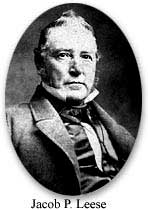 Three
years later, in May 1836, another famous pioneer arrived, Jacob Leese.
On landing in Yerba Buena cove by sea he announced that he would establish
a mercantile business. His partners, who handled a branch at Monterey,
were Nathan Spear and W.S. Hinkley. The Spanish governor at Monterey instructed
the alcalde at Yerba Buena to grant Mr. Leese an allotment of land within
the government reservation. Accordingly, Leese took possession of a 100
vara (1 vara = 33 inches) lot on the south side of Richardson's tent, at
the corner of Clay St. and Grant Ave., 250 yards from the beach, then washed
by the waters of the bay, which came close to the present Montgomery Street.
The building was finished July 4, 1836, and an enthusiastic celebration
was held. Many Spanish dignitaries and their families attended the feast.
The tent and the house erected by Richardson and Leese formed the nucleus
of the present city of San Francisco. Three
years later, in May 1836, another famous pioneer arrived, Jacob Leese.
On landing in Yerba Buena cove by sea he announced that he would establish
a mercantile business. His partners, who handled a branch at Monterey,
were Nathan Spear and W.S. Hinkley. The Spanish governor at Monterey instructed
the alcalde at Yerba Buena to grant Mr. Leese an allotment of land within
the government reservation. Accordingly, Leese took possession of a 100
vara (1 vara = 33 inches) lot on the south side of Richardson's tent, at
the corner of Clay St. and Grant Ave., 250 yards from the beach, then washed
by the waters of the bay, which came close to the present Montgomery Street.
The building was finished July 4, 1836, and an enthusiastic celebration
was held. Many Spanish dignitaries and their families attended the feast.
The tent and the house erected by Richardson and Leese formed the nucleus
of the present city of San Francisco.
Leese married a daughter of General
Vallejo, and on April 15, 1838, Rosalie Leese was joyfully welcomed as
the first child born in Yerba Buena.
The same year Leese erected a much
larger frame building and began to branch out in real estate. Captain Richardson
constructed an adobe building to keep up with the times.
In 1840, Leese sold his properties
to the Hudson Bay Company, and moved to Sonoma. Later he went to Oregon,
then just opening up.
There were about a dozen houses and
fifty residents in Yerba Buena by 1844. But in 1846 the Hudson Bay Company
sold its holdings and left; a move that largely cut down the number of
settlers. For some reason, however, the new town proved a magnet for nomads
and sailors deserting vessel, and towards the close of 1846 there were
some ninety buildings, shanties, adobes and frame houses, and about 200
inhabitants.
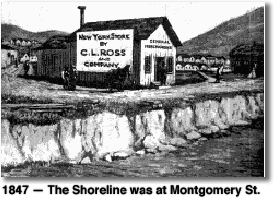 Up
to January 1847, the little village of shacks and occasional buildings
between Sacramento and Washington streets, and from Stockton Street to
the bay shore, which then came up to the present Montgomery Street, was
known as Yerba Buena. Up
to January 1847, the little village of shacks and occasional buildings
between Sacramento and Washington streets, and from Stockton Street to
the bay shore, which then came up to the present Montgomery Street, was
known as Yerba Buena.
There was a lively contest between
two rival factions on the bay shores to capture the name of St. Francis
for their respective towns, Yerba Buena and Benicia. The latter town was
then being backed by a number of strong capitalists, led by Mariano Vallejo
and Thomas O. Larkin. They were determined to make Benicia the capital
of the territory. Washington Bartlett, the first American alcalde, made
a successful flank movement and succeeded in capturing the name San Francisco
and issued the first official announcement
of the change of name.
During 1847, six trading vessels entered
the bay. The population of San Francisco was then 459 souls. The exports
for that year were valued at $49, 597 and the imports $53,589. January
of 1847 brought the first printing press to San Francisco, and on January
7 Sam Brannan published the first newspaper, "The California Star,"
a weekly of four pages.
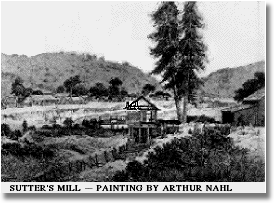 James
Marshall's discovery of gold in the South
Fork of the American River at Sutter's mill on January 24, 1848, started
the great rush of Argonauts to California. James
Marshall's discovery of gold in the South
Fork of the American River at Sutter's mill on January 24, 1848, started
the great rush of Argonauts to California.
But gold had been found in 1843 near
the Mission San Fernando in Southern California. Over $100,000 in gold
was taken within two years, and a large part of it was shipped to the Philadelphia
Mint for coining. But this gold discovery created little attention because
the country was under Mexican rule, communication with outsiders was scant
and there were very few newspapers.
Marshall and Captain John Sutter tried
their best to keep the discovery of gold quiet until the construction of
Sutter's mill was completed, well knowing that the workmen would desert
their jobs and turn to digging gold. The news leaked out, and the
stampede began.
By the following August there were
4000 men washing gold along the American River. At least one-third of this
number were Indians. In all, $50,000 per day in gold was washed from the
banks of the river.
When tidings of this discovery reached
San Francisco, intense excitement prevailed, and this blazed almost into
a mania when the first lucky miners reached the city, and lavishly scattered
their rich findings among the stores, saloons and the many gambling places
in the little town of San Francisco. The newspapers blazoned the exciting
news throughout the state and abroad, and outgoing vessels disseminated
the news at every opportunity. Every resident on the peninsula that could
get away hurried to the mines, and the most famous gold rush in the history
of the world was on.
Early in 1848, the San Francisco City Council made strong efforts to
check the rising tide of gambling, a vice then sweeping the city. An ordinance
was passed to seize all moneys found on gambling tables. The people were
against the law, and it was later withdrawn. That withdrawal paved the
way for the reckless gambling that flooded the town when the first of the
hilarious gold seekers reached the city a few months later. In this period,
1848, sales became more numerous in disposing publicly of the town's real
estate. Some great bargains were then picked up which became the nucleus
of large personal estates. Many lots were sold at from $16 to $50 each.
In 1848, the school census showed a
population of 575 males, 177 females and 60 children, a population of 812.
The buildings numbered 200. there were two hotels, boarding houses, saloons
and ten-pin alleys. Twelve mercantile houses were established, two
more wharves were in the course of construction, the townspeople were hopeful,
and the prospects of the city good. April 3, 1848, the first public school
was opened.
As Spring advanced, the story of gold
findings at Sutter's mill began to spread widely. Very quickly the excitement
leaped to fever heat. Gold became the irresistible magnet and nothing could
check the insistent rush. Laborers, clerks, waiters, servants, all disappeared
as if by magic, and melted into the stream of feverish beings headed for
the slopes of the Sierra.
In the month of May 1848 more than
150 people left San Francisco, and the days added to the departures. On
May 29, "The Californian" announced it could not issue the newspaper
"until further notice" because all of its employees had quit.
Other papers were quickly closed for the same reason. On July 15, the
"Californian" managed to get out slip of a paper announcing "The
Whole World at War" alluding to the Revolution in France. The military
governor of California issued a proclamation calling on the people to assist
authorities in apprehending Army and Navy deserters who had joined the
gold rush. Public schools were ordered closed because of the rush to the
gold fields.
September 1848, was an eventful month to the little community of San
Francisco. Gold dust was the only currency, and a big meeting was called
to establish its value. Everybody in town attended. The ratio was fixed
at $16 per ounce, and payable on all contracts at that rate. Congress was
petitioned to establish a branch mint in San Francisco.
Another very important event was the
arrival of the brig Belfast from New York. She discharged the first real
cargo of merchandise at Broadway wharf. The price of goods in the town
instantly dropped 25 percent, and the value of real estate jumped from
50 to 100 percent. The day previous a lot at Washington and Montgomery
streets was offered at $5000 with no takers. The day after the arrival
of the Belfast the same lot sold for $10,000.
All classes gambled in those days.
Everyone made money, and apparently everyone was becoming a Croesus or
had the chance. Feverish hope was in the air whether fortunes were lost
or won upon green cloth in the gambling dens. Few thought of their occupation
or considered the future. The saloons were crowded night and day by impatient
revelers, who were unable to satiate themselves, so mad were they with
excitement.
After the first wild rush, the cooler
heads began to analyze the situation, and thereafter there was a more intelligent
handling of conditions and prospects. But in 1849 it was a wild revel,
with showers of gold on every side in a young community that had not yet
found itself.
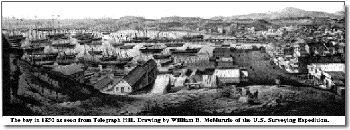 In the
last half of 1849, immigrants arrived at the rate of one thousand per week
by sea alone. In this period large numbers came from South America, the
islands of the Pacific and Australia. Late in the year droves came from
the Eastern States by way of Cape Horn. During the year, 40,000 arrived
in San Francisco, aside from the desertions from vessels. Three-quarters
of them headed for the mines. In the
last half of 1849, immigrants arrived at the rate of one thousand per week
by sea alone. In this period large numbers came from South America, the
islands of the Pacific and Australia. Late in the year droves came from
the Eastern States by way of Cape Horn. During the year, 40,000 arrived
in San Francisco, aside from the desertions from vessels. Three-quarters
of them headed for the mines.
The population of the town, at that
time, was about 25,000, with comparatively few women. There was no such
place as a home, as now understood, and very few habitable houses. Frame
buildings for business and dwelling were the best. Shacks and tents were
common. Only the great gambling houses, hotels, restaurants and a few public
buildings had any pretension to size and comfort. The streets were uneven,
and covered with numberless sand hills. In winter the mud was knee-deep
in the streets, except the few that were planked. Citizens used lanterns
at night because there were no streetlights.
Heaps of imported good disappeared
as if by magic, off to the mines and other shipments appeared in their
stead. In the gambling dens bets were made as high as $20,000 on the turn
of a card, though the ordinary stakes were 50 cents to $5. A half dollar
was the smallest coin in circulation, and a penny, dime or fivecent piece
was a curiosity.
For any small service nothing lower
than 50 cents was given. The entrance to the pit in the circus was $3.
A hearty meal at a good restaurant cost from $2 to $5. Coarse boots were
$30 to $40 per pair; superior boots were $100. Laborers received $1 per
hour, and skilled mechanics from $12 to $20 per day. The carpenters struck
because they were getting only $12 per day, and demanded $16.
San Francisco News Letter
September 1925
Return
to the top of the page.
|